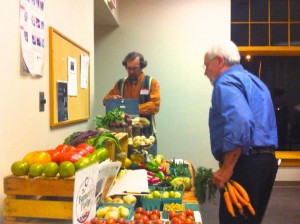Financing a Sustainable Future
On September 21, 2014, hundreds of thousands of protesters marched down the streets of New York City, demanding that world leaders about to meet at the United Nations Climate Summit lay the groundwork for meaningful action to address global climate change. The day before the climate march, a panel discussion on sustainable finance was sponsored by some of the march’s organizers. This panel sought to tie together the themes of building an equitable economic system and achieving environmental sustainability. Particular focus was given to meaningful policy actions that could be taken at the state and local levels.
One of the panelists participating in the discussion was Chris Hewitt, executive director of the Hudson Valley Current, a mutual credit system in the mid-Hudson Valley that I have the privilege of working for through the Bard Center for Environmental Policy internship program.
The Hudson Valley Current is one example of the thousands of locally managed credit systems that exist throughout the world. Such systems are often established as a local strategy to access a reliable source of capital during economic downturns or periods of inflation. Many, including the Hudson Valley Current, also seek to support environmentally sustainable patterns of consumption.

The Nuts and Bolts of a local Mutual Credit System — the Hudson Valley Current
The Hudson Valley Current has succeeded in creating over 30,000 dollars’ worth of credit (called “Currents”) in Ulster and Dutchess counties since the beginning of 2014, the organization’s first full year of operation. Local independent businesses and self-employed individuals are given accounts through an online software system that allows them to buy and sell goods and services from other users in the Current’s online marketplace or by using a Hudson Valley Current app.
You might be wondering how Currents are actually created in the Hudson Valley Current system. Simply put, they’re created when users exchange goods or services. When a new Current account is created, it initially starts off at zero Currents. When a user sells a good or service through the Current system, their account is credited Currents (1 Current = 1 dollar and prices are based on prevailing market prices in dollars). When a user buys a good or service, their account is debited. Users are generally allowed to spend below zero until they reach a standard debit limit. Debits are repaid by selling goods or services through the Current network. This feature allows users to access a reliable source of interest-free credit as needed. Credit extended through the Hudson Valley Current system has included critical start-up capital for a new business, as well as facilitating the purchase of health care services for self-employed individuals.
The Environmental Connection
This brings us back to the sustainable finance panel held on the eve of the September 2014 climate march. The Hudson Valley Current may be able to contribute to local economic development, but how does it contribute to a more environmentally sustainable future? And what part does a graduate student studying environmental policy at Bard CEP play in all of this?
To answer the second question first, Bard CEP’s interdisciplinary approach to environmental policy coursework in the first year of its graduate program has equipped me to contribute in several important ways to the workings of the Hudson Valley Current. My courses in applied economics helped develop the skillsets I’ve needed to assist in the Current’s database management and analysis, while courses in policy and law have allowed me to make meaningful contributions to strategic discussions about how the Hudson Valley Current can navigate applicable regulatory landscapes. And, of course, classes in environmental science have given me background knowledge that can be used to help identify potential partners and programs that will further the organization’s sustainability goals.
The first question, about how the Current contributes to a more environmentally sustainable future, has several possible answers, some of which I’ll disucss in my next blog host. However, I think the most straightforward answer is that the Hudson Valley Current can give environmentally minded individuals and organizations at the grassroots level another critical tool with which to implement their goals. Just as local small businesses can benefit from an interest-free extension of credit, a major goal of Current administrators is to play a critical role in financing many of the small-scale, grassroots endeavors to build a greener future that are already underway in the mid-Hudson Valley.
For example, the Hudson Valley Current is presently fostering partnerships with a number of diversified farms in the mid-Hudson Valley, as well as with local farmers’ markets. The goal is to assist sustainably-minded local farmers by providing a platform via the Current to purchase advertising and/or to pay farmers’ market fees. In return, farms could accept Currents as partial or full payment for their products, or even offer community supported agriculture shares that are payable through the Current system.

Source: The Hudson Valley Current
To be sure, this is a small-scale, local endeavor still in its early stages. Like all social (and business) enterprises, success is not guaranteed. And yet, the mid-Hudson Valley, with its working farms, land conservation projects, and sustainable energy initiatives, remains a promising place for those seeking to build a “greener” future. The early successes of the Hudson Valley Current gives hope that this mutual credit system can help facilitate many of the exciting environmental initiatives already underway in our region.
